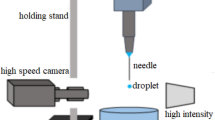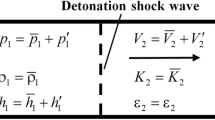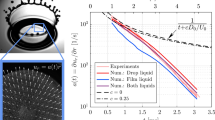A numerical study has been made of the influence of the droplet distribution in a “water slug” on the integral characteristics of heat and mass transfer (temperature and concentration of the gases in its wake) in motion through high-temperature combustion products of typical combustible wood. Limiting values of the parameters characterizing the position of the droplets relative to the neighboring droplets in the “water slug” at which minimum temperatures and concentrations of the combustion products in its wake are attained under the conditions of the greatest possible completeness of water evaporation, have been established. It has been shown that a series–parallel droplet distribution in the “water slug” is expedient for efficient action on the high-temperature gases.
Similar content being viewed by others
References
I. R. Khasanov and E. A. Moskvilin, Aviation methods of quenching large forest fires, in: Problems of Burning and Quenching Fires at the Turn of the Centuries, Proc. 15th Sci.-Pract. Conf., Pt. 1, VNIIPO, Moscow (1999), pp. 300–301.
V. S. Gorshkov, E. A. Moskvilin, and I. R. Khasanov, Estimation of the parameters of quenching forest fires by aviation means, in: Problems of Predicting Extraordinary Situations and of Their Sources, Volume of Abstracts of Sci.-Pract. Conf., IITs VNII GOChS, Moscow (2001), pp. 34–35.
A. V. Karpyshev, A. L. Dushkin, and N. N. Ryazantsev, Development of a highly efficient universal fire extinguisher on the basis of generating jets of finely pulverized fire-extinguishing substances, Pozharovzryvobezopasnost', 16, No. 2, 69–73 (2007).
D. Gaev, A. V. Ershov, V. P. Prokhorov, A. V. Karpyshev, and A. L. Dushkin, A system of fire protection for the subway car cabin on the basis of high technologies, Probl. Bezop. Chrezv. Situats., No. 3, 67–72 (2009).
A. L. Dushkin and S. E. Lovchinskii, Interaction of a combustible fluid flame with finely pulverized water, Pozharovzryvobezopasnost', 20, No. 11, 53–55 (2011).
V. V. Sokovikov, A. N. Tugov, V. V. Grishin, and V. N. Kamyshev, Automatic water fire-fighting using finely pulverized water at electric power stations, Énergetik, No. 6, 37–38 (2008).
A. A. Salamov, Modern fire-fighting high-pressure “water fog” system, Énergetik, No. 3, 16–18 (2012).
R. S. Volkov, G. V. Kuznetsov, and P. A. Strizhak, Numerical estimation of the optimum size of water droplets under conditions of indoor water atomization by fire-quenching means, Pozharovzryvobezopasnost', 21, No. 5, 74–78 (2012).
D. O. Glushkov, G. V. Kuznetsov, and P. A. Strizhak, Numerical investigation of heat and mass transfer in motion of a tandem of water droplets in a high-temperature gas medium, Tepl. Prots. Tekh., 4, No. 12, 531–538 (2012).
P. A. Strizhak, Numerical investigation of the conditions of water droplet collection evaporation during motion in a high-temperature gas medium, Pozharovzryvobezopasnost', 21, No. 8, 26–31 (2012).
O. V. Vysokomornaya, G. V. Kuznetsov, and P. A. Strizhak, Heat and mass transfer in the process of movement of water drops in a high-temperature gas medium, Inzh.-Fiz. Zh., 86, No. 1, 59–65 (2013).
R. S. Volkov, O. V. Vysokomornaya, and P. A. Strizhak, Numerical investigation of the conditions of interaction of a dispersed combustion phlegmatizer with high-temperature combustion products, Bezopasn. Truda Promyshl., No. 10, 74–79 (2012).
G. G. Andreev, D. O. Glushkov, V. F. Panin, and P. A. Strizhak, Heat and mass transfer during interaction of a dispersed combustion phlegmatizer with high-temperature combustion products, Butlerovsk. Soobshch., 31, No. 8, 86–94 (2012).
P. A. Strizhak, Numerical analysis of the process of evaporation of a droplet moving in a water jet through high-velocity combustion products, Pozharovzryvobezopasnost', 21, No. 9, 17–23 (2012).
N. V. Baranovskii and G. V. Kuznetsov, Prediction of the Onset of Forest Fires and of Their Environmental Consequences [in Russian], Izd. Sib. Otd. RAN, Novosibirsk (2009).
V. V. Dubovitskii, A. M. Podvysotskii, and A. A. Shraiber, Measuring natural oscillation periods for droplets and twocomponent particles, Inzh.-Fiz. Zh., 58, No. 5, 804–808 (1990).
E. H. Trinh, R. G. Holt, and D. B. Thiessen, The dynamics of ultrasonically levitated drops in an electric field, Phys. Fluids, 8, No. 1, 43–61 (1996).
L. G. Loitsyanskii, Mechanics of Liquids and Gases [in Russian], Nauka, Moscow (1970).
S. S. Kutateladze, Principles of Heat Transfer Theory [in Russian], Atomizdat, Moscow (1979).
V. M. Paskonov, V. I. Polezhaev, and L. A. Chudov, Numerical Simulation of Heat and Mass Transfer Processes [in Russian], Nauka, Moscow (1984).
D. A. Frank-Kamenetskii, Diffusion and Heat Transfer in Chemical Kinetics [in Russian], Nauka, Moscow (1987).
G. V. Kuznetsov and P. A. Strizhak, Ignition of liquid hydrocarbon fuels by an ignited solitary particle, Izv. Tomsk. Politekh. Univ., 316, No. 4, 5–9 (2008).
T. M. Muratova and D. A. Labuntsov, Kinetic analysis of evaporation and condensation processes, Teplofiz. Vys. Temp., 7, No. 5. 959–967 (1969).
O. Knake and I. N. Stranskii, Evaporation mechanism, Usp. Fiz. Nauk, 68, No. 2 (1959).
A. A. Samarskii, Theory of Difference Schemes [in Russian], Nauka, Moscow (1983).
G. V. Kuznetsov and P. A. Strizhak, Transient heat and mass transfer at the ignition of vapor and gas mixture by a moving hot particle, Int. J. Heat Mass Transf., 53, Issues 5–6, 923–930 (2010).
N. B. Vargaftik, Handbook of Thermophysical Properties of Gases and Liquids [in Russian], OOO “Stars,” Moscow (2006).
V. N. Yurenev and P. D. Lebedev (Eds.), Heat Engineering Handbook [in Russian], Vols. 1, 2, Énergiya, Moscow (1975).
A. P. Kryukov and V. Yu. Levashov, About evaporation–condensation coefficients on the vapor–liquid interface of high thermal conductivity matters, Int. J. Heat Mass Transf., 54, Nos. 13–14, 3042–3048 (2011).
Author information
Authors and Affiliations
Corresponding author
Additional information
Translated from Inzhenerno-Fizicheskii Zhurnal, Vol. 86, No. 4, pp. 839–848, July–August, 2013.
Rights and permissions
About this article
Cite this article
Strizhak, P.A. Influence of droplet distribution in a “water slug” on the temperature and concentration of combustion products in its wake. J Eng Phys Thermophy 86, 895–904 (2013). https://doi.org/10.1007/s10891-013-0909-9
Published:
Issue Date:
DOI: https://doi.org/10.1007/s10891-013-0909-9




